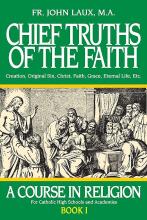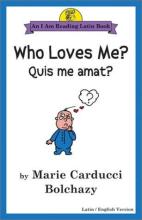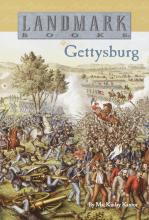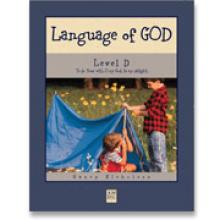No name
Chief Truths of the Faith
Originally published in 1928, the current edition published by TAN Books is a complete reproduction of the 1934 edition. The 1990 editor added some footnotes to bring the series more "up-to-date." This is a highly recommended series — it is the recommended high school religion text for Kolbe Academy, Mother of Divine Grace and Seton Home Study. I have not worked my way through an entire book from this series yet, but I found it to be an excellent reference resource, especially before the Catechism of the Catholic Church was released. It makes an excellent reference because it is laid out in a very practical manner. It is possible to study a single chapter in the middle of the book in order to more fully understand a particular topic, such as the Catholic Church's teaching on Evolution (ch. VI, Bk. 1 The Origin of the Human Race) which did not change with Vatican II or Our Holy Father's recent (and highly misunderstood and misquoted) statement on Evolution. Because of this practical format, parents may find this series very useful in learning about a particular concept more fully in order to teach it to their younger children. The series is extensively illustrated.
The full series of Fr. Laux's "A Course in Religion" includes the following titles:
- Chief Truths of the Faith (Book I)
- Mass and the Sacraments (Book II)
- Catholic Morality (Book III), and
- Catholic Apologetics (Book IV)
For those interested in using this as a high school religion series, Laura Berquist has syllabi for this series, which include quizzes and answer keys and are available from Emmanuel Books. Seton Home Study offers, even for those not signed up with their entire program, a course using this text. This service includes telephone consultation, test correcting, grading, etc.
How Many Animals?/Quot Animalia?
What a great idea - simple Latin readers to introduce young children to the language. Big pictures are paired with large, clear print, just like an English easy-reader. This first book in the series is a simple picture book with very nicely drawn, realistic pen and ink illustrations. The format allows readers to intuitively figure out what some basic words mean by connecting them with the pictures. The text introduces 13 types of animals, offering each Latin word in the singular and plural. The reader is also exposed to the Roman numerals from I-XII, and C as well as the Latin names for the same numbers. Just the last few pages introduce a few more words, including some relevant adjectives. The book wraps up with a complete translation, glossary and notes in the back.
This is a really nice beginning book for young children - particularly those whose older siblings are studying the language. Highly recommended!
Donated for review by Bolchazy-Carducci
What Color Is It?/Quo colore est?
This title offers charming, child-friendly pen-and-ink illustrations to introduce the colors (in Latin) to young children. The text is quite a bit more complex than How Many Animals? Quot Animalia?, but would provide a good opportunity for young Latin scholars to practice their pronunciation by reading the book aloud to a younger sibling. Since the topic is "colors", I think this book will be best enjoyed if an artist in the family colors in the illustrations first. Translations and glossary are in the back.
Donated for review by Bolchazy-Carducci
What Will I Eat?/Quid Edam?
Lots of silly black-and-white pictures (which will likely appeal to certain funny-bones) and simple text introduce readers to the Latin words for many types of food. You'll find a monster eating pizza, a cow suggesting pork instead of beef, a hot dog enjoying a soda and... lots of good Latin content. Not my favorite book in this series, but perhaps not a bad way to introduce young children to some relevant Latin vocabulary. Young readers will probably not be ready to translate all the sentences on their own, but they can learn to recognize basic words and get a feel for the sound of the language.
Donated for review by Bolchazy-Carducci
Who Loves Me? / Quis me amat?
This book introduces names of family members - mother, father, sister, brother, grandfather, grandmother, fraternal and paternal aunt and uncle, cousins and God - through the eyes of a baby. I liked how small details on some of the pictures - like the words on a T-shirt - are written in Latin (and the translations are included in the back along with the rest of the text). The text is charming, but these pictures are a bit on the "goofy" side (very cartoon like and some weird proportions). For me, the pictures detracted somewhat from the text (although I admit to being a person who is rather fussy about illustrations - particularly in children's books). Also, there is a slight editing problem on pages 13-14 where the illustrations of the paternal and fraternal aunts are mixed up.
Donated for review by Bolchazy-Carducci
Gettysburg
The Civil War Battle of Gettysburg, Pennsylvania (July 1 – 3, 1863) is a complex, multi-faceted piece of history that would be difficult to understand after reading just one book. If you ever find yourself in the South-Central Pennsylvania, I would recommend a visit. I've been there twice and it's very a moving, historically interesting site.
This book offers a glimpse into a number of aspects of the human side of the war. The author met with a number of Civil War veterans personally, and so the accounts contained within the book are very human and anecdotal. He tries to give us a sense of the flavor of life in that time period; the way people thought about each other – particularly those on opposite sides of the Potomac River.
Like many Landmark books, this probably isn't the first place you want to turn to in studying about Gettysburg – and this one isn't quite as cohesive as I would like. I think it would be most interesting and accessible to upper grade schoolers who had already become familiar with events in a general way from a textbook or from a visit to the battlefield. My 11 year old daughter tackled this independently this past year in the midst of other books on the civil war as well as bits and pieces of Ken Burns' Civil War documentary and enjoyed and benefited from it.
The Swamp Fox of the Revolution
Back in print! This interesting and entertaining story is a biography of Revolutionary War General Francis Marion and his significant but oft-forgotten role in winning our independence. Marion is a very interesting character I should have learned about in my history classes in grade school! He fought the British against what seemed like impossible odds (in the Southern Colonies) and ended up playing a very significant role in winning the British surrender. His courage and mercy (he allows his prisoners go free if they promise not to rejoin the other side) are admirable.
The reprint retains the index from the original Landmark book.
Originally published by Random House in 1959 as a Landmark book.
Reprinted 2008 by Sterling Point Books. Book details are for the reprint.
Language of God for Little Folks (Level D)
Designed for 4th or 5th grade, this level of the popular Catholic grammar curriculum is another winner! The book has been improved from the earliest editions of the lower levels by using a high-quality, bright-white, erasable paper with a lay-flat spiral binding. The 120 exercises in the worktext provide four short lessons per week for thirty weeks, including regular review of concepts already taught on lessons titled "Practice". There are no tests, although the "Practice" pages could be used as tests. The examples and exercises are gently Catholic, using bits of Catholic history, explanations of Catholic customs, and illustrations from daily family life as the sentences upon which the students practice. Pictures are simple black-and-white drawings and sketches and add to the simplicity of the book. It is very refreshing to use a text that is not filled with politically correct rhetoric and visually overwhelming photos and diagrams!
This level reviews grammar topics covered in earlier grades and extends these topics with grade-level information. A study of the parts of speech and their usage comprises the majority of the lessons. An introduction to traditional sentence diagramming (7 lessons) and sentence construction is also included (about 10 lessons). The exercises require very little actual pen-and-paper work and are ideal for a child who struggles with the physical act of writing. To practice a child's handwriting and to improve his retention, I have my children copy some of the daily practice sentences into their grammar notebooks, rather than just filling-in-the-blanks. For a student of this age, this text is not a complete language arts curriculum; you will also need regular composition exercises.
Copyrights 2001/2005









